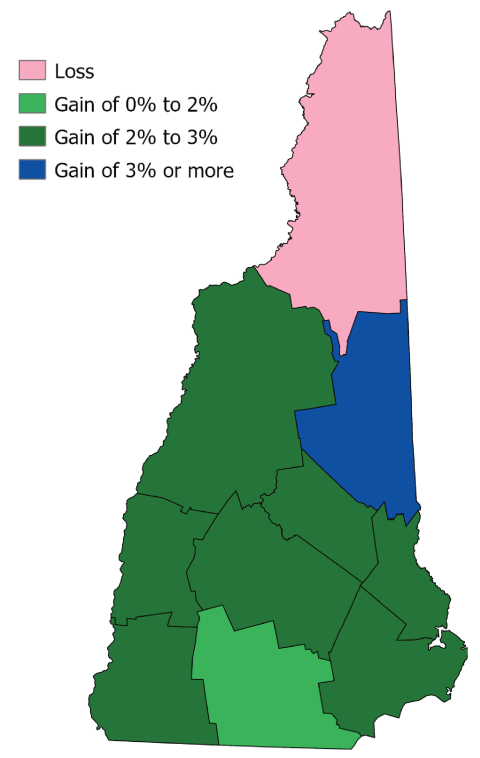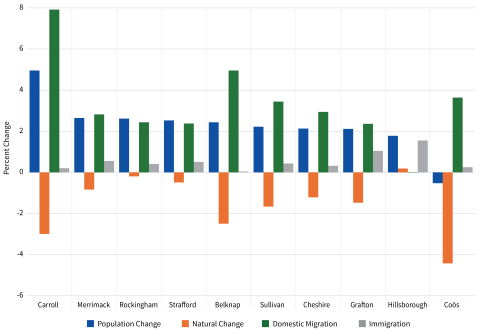download the brief
Key Findings

Migration continues to fuel population growth in New Hampshire, according to new Census data.

Nine of the state’s ten counties gained population between 2020 and 2024, even though more people died than were born in the state.
New Hampshire’s population reached 1,409,032 on July 1, 2024, an increase of 6,800 since July 2023, according to new Census Bureau estimates. The state’s population gain was larger than the prior year’s, but smaller than in the two preceding years. Between 2023 and 2024, New Hampshire had a net gain of 9,200 people from migration, which offset a loss of 2,400 more deaths than births. Nine of the state’s ten counties gained population between July 2023 and July 2024, with only Coös County experiencing a minimal population loss.
Migration Fueled All of New Hampshire’s Population Gain Since 2020
Since the 2020 Census, New Hampshire’s population has increased by 31,500. Surprisingly, the state’s population grew even though it had 9,200 more deaths than births between 2020 and July 2024. Migration accounted for the entire population gain. In all, 40,100 more people moved to the state than left it. Most of these migrants came from elsewhere in the United States; such domestic migrants accounted for 29,200 migrants (73 percent), but the state also received 10,900 immigrants. New Hampshire’s percentage population gain since 2020 exceeded that of every state in the Northeast except Maine.
Nine of New Hampshire’s counties gained population between 2020 and 2024 compared to just 58 percent of all counties nationwide. However, the magnitude of the population changes in New Hampshire since the 2020 Census varied from county to county (Figure 1). Carroll County had the largest percentage population gain, growing by 5.0 percent since 2020. The next fastest growing counties were Rockingham and Merrimack at 2.6 percent. Rockingham County also had the largest numerical gain of 8,200. Coös County had a minimal population loss of 165 residents (0.4 percent) over the four-year period.
Such widespread population gains are surprising given that deaths exceeded births in nine of New Hampshire’s ten counties. Only Hillsborough County had more births than deaths (800) between 2020 and 2024, though the gain was just 0.2 percent (Figure 2). Natural losses from deaths exceeding births were greatest in Coös (-4.4 percent), Carroll (-3.0 percent), and Belknap (-2.5 percent) Counties. Covid contributed to these widespread natural losses, but annual deaths have exceeded births in the state in each of the last eight years.
Figure 1. New Hampshire Counties Percentage Population Change, 2020 to 2024

Source: U.S. Census Bureau Estimates. Analysis: K.M. Johnson, UNH Carsey School.
Figure 2. Demographic Change in New Hampshire Counties, 2020 to 2024

Source: U.S. Census Bureau Estimates. Analysis: K.M. Johnson, UNH Carsey School.
Migration has also long provided most of the state’s population gain. All ten counties gained migrants between 2020 and 2024. By far the largest migration gain of 8.1 percent was in Carroll County. This county has long attracted recreational and amenity migrants, including many from large urban areas. This influx accelerated during the pandemic era. Carroll County had the state’s largest population gain because its substantial migration gain offset the county’s significant excess of deaths over births. In northernmost Coös County, where deaths far exceeded births, migration was not sufficient to offset the natural decline leading to a modest population loss. Even in Hillsborough County, where births did exceed deaths, migration produced nearly all of the
population gain.
In New Hampshire as a whole, as well as in nine of its ten counties, migration from other U.S. destinations (domestic migration) accounted for most of the population gain. The exception is Hillsborough County, where immigration from abroad accounted for the entire migration gain, even offsetting a minimal domestic migration loss. Hillsborough’s demographic trends are similar to those in many large metropolitan areas where natural increase and immigration tend to offset a loss of domestic migrants. New Hampshire and its counties also mirror recent demographic trends elsewhere in the nation, with immigration contributing more to the overall population gain in the past year than was common earlier in the decade.
These new Census data underscore the continuing importance of migration to New Hampshire’s demographic future. Such migration gains accrue both from attracting migrants to the state and retaining more existing residents, highlighting the importance of developing policies that do both. Such policies need to ensure that New Hampshire communities have the plans, resources, and infrastructure to support both migrants and existing residents with a quality education system, economic opportunities, affordable housing, access to health and child care, and opportunities to enjoy the state’s scenic, environmental, and recreational amenities.
Methods and Data
This analysis is based on Census Bureau Population Estimates for April 1, 2020, to June 30, 2024, released on March 13, 2025. The Bureau uses the best data and algorithms available at the time of release to generate the data, but they remain estimates and are subject to future revision.
About the Author
Kenneth M. Johnson is senior demographer at the Carsey School of Public Policy, professor of sociology at the University of New Hampshire, and an Andrew Carnegie Fellow. His research is supported by the NH Agricultural Experiment Station through joint funding from the USDA National Institute of Food and Agriculture (under Hatch-Multistate project W5001, award number 7003437) and the state of New Hampshire. Tyrus Parker and Barb Cook of the Carsey School provided research support. The opinions are his and not those of the sponsoring organizations
© 2025. University of New Hampshire. All rights reserved.